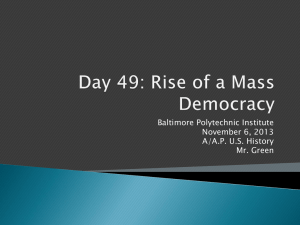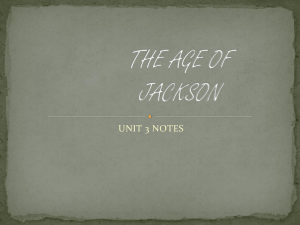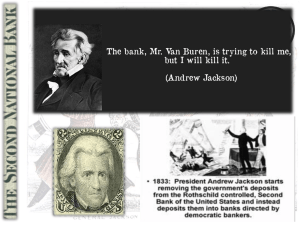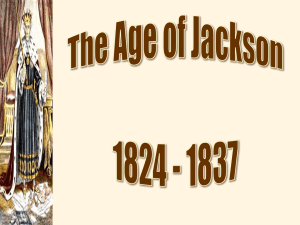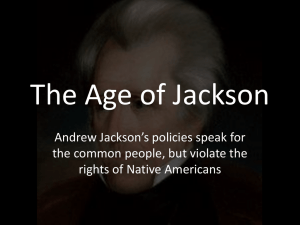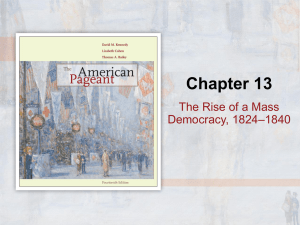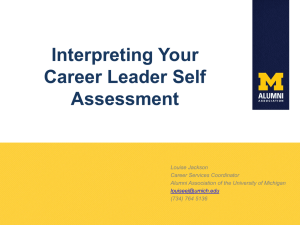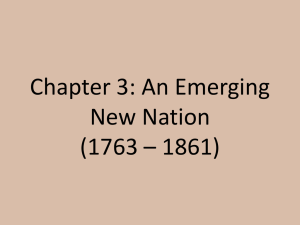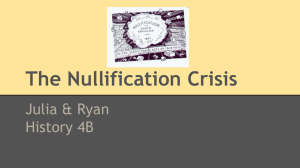The Age of Jackson, Reform and Industrial Growth
advertisement
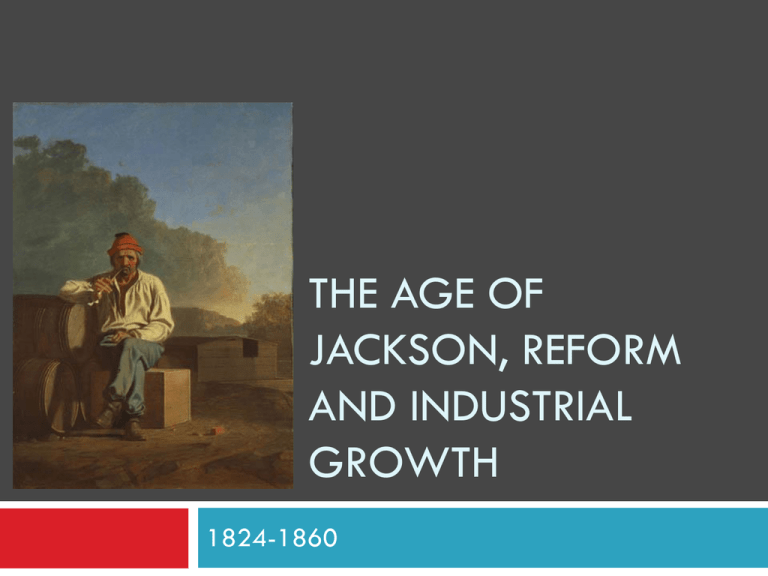
THE AGE OF JACKSON, REFORM AND INDUSTRIAL GROWTH 1824-1860 The Rise of Mass Democracy 1825-1840 I. The Corrupt Bargain Early 1820’s sectional differences emerge after the Panic of 1819 and the Missouri Compromise New types of political parties emerged, became accepted New styles of campaigns, banners, badges, politicking 1828 new party, Democrats 1830’s Whig Party emerges Two party system part of checks and balances of political power More people began to vote (78% in1840) I. The Corrupt Bargain 1824- Last of the old style elections Adams (MA), Clay (KY), Wm. Crawford (GA), Jackson (TN) all running for president Jackson strongest personal appeal, support from the West Won a majority of the vote, did not win in electoral college Clay (also Speaker of the House), threw support behind Adams Clay hated Jackson (from 1818 Florida foray) Did not like Adams either, but both were nationalist I. The Corrupt Bargain 1825 vote in House gave election to Adams, Clay becomes Sec. of State (seen as stepping stone to presidency) Supporters of Jackson called it a corrupt bargain Condemned Clay No positive evidence of “corrupt bargain”, Clay was qualified to be Sec. of State Changed political system, no more elections behind closed doors II. Yankee Misfit in the White House Adams could be an irritable loner Great Sec. of State, poor president Not good at politics Did not have popular support Kept people in office, didn't do political favors for supporters Nationalistic views and ideas in contrast with national mood turning towards sectionalism and state’s rights Southerners thought he might take infringe on their “peculiar institution” Land policies and Indian policies turned off Westerners III. Going “Whole Hog” for Jackson in 1828 By 1828 Democrat-Republicans split into two groups National Republicans supported Adams Republicans supported Jackson Jackson seem as champion of common man Mudslinging, accusations in election of 1828 Vote split along sectional lines West and South supported Jackson New England supported Adams Vote split in rest of country but Jackson won the electoral vote handily Shift of political power from eastern seaboard to emerging western states IV. Old Hickory as President Jackson from humble beginnings Force of personality and power of leadership led to rise to national prominence First president from the west, frontier aristocrat, slave owner Election seen as rise of “peoples champion” Wild inauguration, supporters flooded Washington, and wrecked White House Conservatives saw this as the rise of the dreaded democratic mob V. The Spoils System Under Jackson spoils system used on a large scale (rewarding supporters with political jobs) Washington was due for an overturn in the established powers, many had been around since the early 1800’s Rewarding cronies led to scandal, but it was an important element to the development of the two party system Promise of “spoils” led to party loyalty instead of economic, class and geographic loyalties VI. The Tricky “Tariff of Abominations” Tariffs had protected American Industry against European competition Invited retaliatory tariffs against American goods Tariff raised in 1824, 1828 Southerners thought tariffs discriminated against them Tariff of 1828 called “Tariff of Abominations”, “Black Tariffs” Southerners sold goods on world market, unprotected by tariffs, forced to buy manufactured good in a market protected by tariffs Northeast was having a boom in manufacturing, how was the South doing? Tariff was an easy scapegoat VI. The Tricky “Tariff of Abominations” These feeling were heightened by the fear that the federal government would interfere with slavery Missouri Compromise, Denmark Vesey slave rebellion (1822), mounting pressure in support of abolition (in US and abroad) Tariff seen as issue to the South as a way to take a stand for states’ rights South Carolina took the lead 1828 The South Carolina Exposition secretly written by John Calhoun (vice president) Wrote that tariff was unjust and unconstitutional, proposed that states should nullify tariff within their own borders VI. “Nullies” in South Carolina Tariff of 1832 tipped balance in SC to support nullification Delegates declared tariff null and void in state Threatened to take state out of the Union No other Southern states actively supported SC actions Jackson would not permit defiance, dispatched military reinforcements to state to enforce, collect tariff Jackson endorsed tariff Henry Clay stepped in to broker a compromise VI. “Nullies” in South Carolina Compromise Tariff Bill of 1833-would reduce tariff 10% over 8 years Debate broke down over sectional lines South favored compromise, Jackson would not have to use the military Force Bill also passed at the same time, authorized president to use military to collect tariff SC delegates met again repealed ordinance of nullification, but they nullified force bill Only winner was Clay, seen as hero that saved the country VII. The Trail of Tears Jacksonians committed to Western Expansion, Native Americans in the way Since 1790’s American policy toward Indians, they were recognized as separate nations Acquired land through treaties, terms violated regularly as Anglo settlement pushed west Some tribes assimilated into American culture, some resisted it Cherokee of GA, NC assimilated into American ways (part of 5 Civilized Tribes- Creek, Choctaw, Seminole, Chickasaw) Cherokee embraced civilization- written constitution, written legal code, alphabet Some were even slave holders 1830- Congress passes Indian Removal Act, appropriated money to remove Indians to permanent reservation west of the Mississippi (act supported by Jackson, Southerners and Westerners) Jackson, like many Westerners thought Indians needed to be removed east of the Mississippi, open land to white settlement VII. The Trail of Tears 1828- Georgia Legislature declared Cherokee tribal council illegal, asserted jurisdiction over their lands Cherokees appealed to Supreme Court (two separate cases) Court upheld rights of Indians Jackson disagreed with the Supreme Court, ordered removal of Indians (“Marshall made his decision, now let him enforce it”) Uprooted more than 100,000 Indians, westward movement known as the Trail of Tears 1836 Bureau of Indian Affairs established to administer relations with Native Americans As settlers pushed west the permanent frontier for Indians gradually shrank and many other guarantees went up in smoke VII. The Trail of Tears Sauk and Fox Indians in Wisconsin and Illinois resisted eviction Led by Black Hawk the rebellion was crushed by American troops in 1832 (Black Hawk War) Seminoles waged a bitter guerilla war for seven years in the swampy Everglades (1835-1842) Leader Osceola was captured under a flag of truce, some fled deeper into the swamps, 4/5’s were moved to Oklahoma VIII. The Bank War Jackson distrusted big business and the Bank of the US Why? Banks minted gold and silver coins Paper money printed by private banks (value fluctuated with health of bank and amount of money printed Bank of US source of credit, principle depository of federal money, source of credit and stability Acted like another branch of government VIII. The Bank War Bank not accountable to people, existed to make a profit for investors, seen as against “American "way 1832 Bank War begins Webster, Clay push for recharter of Bank to make it a political issue in election of 1832 If passed and signed by Jackson it would alienate his western followers, if vetoed he would loose support of wealthy, influential easterners Jackson vetoed, declared bank unconstitutional, found it harmful to nation Another instance of Jackson regarding executive branch superior to judicial branch Jackson expands power of executive branch IX. Old Hickory Wallops Clay in 1832 Clay and Jackson squared off in election of 1832 First time third party ran, Anti-Masonic Party Supporters in NY, Middle states, New England Against secret societies, support from evangelical Protestants (use political power to bring moral and religious change) Jacksonians against government interference in social and economic life First use of nominating conventions Clay had support from businessmen and eastern newspapers Jackson wins election handily (219-49 in electoral college X. Burying Biddle’s Bank Charter for Bank of US expire 1836 Fear of Biddle to bring back bank, Jackson wants to take it out 1833 Jackson removes federal deposits, bleed bank dry Had to reshuffle cabinet to find people to support him Biddle calls in loans from Bank to show importance, causes financial panic Jackson places funds in state banks (“pet banks”) Banks flood country with paper money, currency becomes unreliable 1836- Specie Circular required public lands to be purchased with hard currency (gold, silver currency) Put brakes on land speculation, sales Causes financial panic and crash in 1837 XI. The Birth of the Whigs 1830’s new political party emerges- Whigs Hatred of Jackson was what they rallied around Whigs were led by Clay, Calhoun, Webster Attracted groups alienated by Jackson- supporters of American System, southern states righter's, northern industrialists, absorbed evangelical protestants from AntiMasonic Party Progressive in support of active government programs and reforms, called for internal improvements Supported prisons, asylums, public schools and the market economy Claimed to be defenders of common man (stole from Democrats) XII. Election of 1836 Martin Van Buren chosen as Jackson’s successor Whigs don’t nominate single candidate, many candidates for regional appeal Wanted to put election in hands of House Van Buren won election easily Van Buren inherited problems over which he had no control Did not have the force of personality that Jackson had to deal with problems Depression, possible war with Canada, depression XIII. Depression, Doldrums and the Independent Treasury Panic 1837 caused by over-speculation on lands, borrowed money based on shaky currency and wildcat banks Jackson’s policies on the Bank of the US Rising grain prices British Banks calling in loans Caused commodity prices to drop, land sales to fall off, factories closed, high unemployment and bank closures XIII. Depression, Doldrums and the Independent Treasury Whigs tried to make government more active to end depression (expansion of credit, tariffs), Van Buren kept government out of economy Van Buren tried to help economy through the “Divorce Bill”, keeping government out of banking by establishing an independent treasury, caused credit to shrink Not popular 1840- Passed by Congress, repealed next year, revived in 1846 and continued until the Civil War XIV. Gone to Texas Americans want Texas, remote backwater of Spanish Empire US abandoned claim in 1819 1823- new Mexican government gives land to Stephen Austin to bring settlers 2 conditions settlers had to become Mexican citizens, become Catholic Ignored by settlers, annoyed by presence of Mexican soldiers and government Settlers typical American individualist, did not want to be pushed around Slavery an issue, outlawed in Mex., settlers brought slaves anyway 1836 Mex. Leader Santa Ana attempts to repress Texans independence XV. The Lone Star Rebellion Early 1836 Texans declare independence Santa Anna attacks Alamo and Goliad become rallying cries for Texans, galvanized Americans behind Texas cause Gen. Sam Houston lures Mexicans east to San Jacinto (near present day Houston), and defeats Santa Anna Forces Santa Anna to sign treaty giving land to Rio Grande to Texas and removing troops from region Mex. Does not recognize agreement Texas becomes an independent republic but wanted to be part of the United States Refused admission, abolitionists did want new slave state Seen as a plot against slavery to Southerners XVI. Log Cabins and Hard Cider of 1840 1840 Van Buren runs again for president, Whigs get behind one candidate William Henry Harrison Harrison, war hero and Indian fighter Views n issues vaguely known Played as a “common man”, really from old Virginia family Selected John Tyler as VP Plan was to drive corrupt Jacksonians from White House Harrison won, time for Whig ideas of government action to stimulate the economy XVII. Two Party System 1840’s American politics adopt populist, democratic style Old aristocracy seen as bad Politicians wanted to claim humble beginnings, politicians had to adopt “common touch” Resulted in formation of vigorous and durable two party system Both parties grew out of Jeffersonian Republicanism Democrats were for the liberty of the individual, state’s rights, federal restraint Whigs supported national bank, protective tariffs, internal improvements and moral reforms Both mass based, appeal led to compromise within the parties, kept extreme views from becoming dominant, reduced sectionalism FORGING THE NATIONAL ECONOMY 1790-1860 I. Westward Movement Americans constantly pushed west, cheap land opportunity First part of 19th century new immigrants joined movement (Irish, Germans) New machinery allowed crops to be cultivated quicker, goods produced faster, expectations for workers changed New methods of transportation allowed goods, people and products to move quicker Origins of market oriented economy I. Westward Movement Jackson symbolized the rise of trans-Appalachia Raw frontier seen as typically American 1850 half of all Americans under 30 Seen as restless energetic, always on the move Demographic center of America had move steadily westward Reality of pioneer life was grim (especially for women) Rugged individualism became part of national character- Was this true? II. Shaping the Western Landscape People molded physical environment Left behind fields destroyed by tobacco cultivation Planted “Kentucky Bluegrass” from charred canfields, 1820-1840 trappers, mountain men had decimated beaver across the West Buffalo, sea otters were hunted into near extension for their fur Ecological Imperialism- exploitation of Americas natural bounty II. Shaping the Western Landscape Many Americans revered nature American wilderness seen as unique to many Europeans Wild unspoiled land one of the nations defining attributed- move west you can always start over Inspired literature, painting and by the end of the 1800’s a conservation movement III. The March of the Millions Population doubling every 25 years By 1860 there were 33 states, 4th most populous country in the world Urban growth- by 1860 there were 43 cities with more than 20,000 (1790 only 3) Urbanization brought problems (inadequate public services, poor housing) 1823 Boston developed first sewer system, 1842 NYC first piped in water supply III. The March of the Millions By 1840’s population growth comes from immigration Most Irish and German What caused them to come to America? Europe had surplus of population, running out of room America seen as land of opportunity Freedom of European class system Abundant, cheap land No compulsory military service IV. The Emerald Isle Moves West Mid 1840’s potato crop failure pushes many out of Ireland 1830-1860 2 million Irish come to the United States New comers too poor to buy land, stayed in cities on eastern seaboard (NYC largest Irish city in the world) Irish had to take worst jobs, poorest housing- viewed as a social menace Competed with African Americans for jobs (Irish did not support abolition) Formed Irish only clubs (Ancient Order of Hibernians, Molly Maguire's) IV. The Emerald Isle Moves West Irish acquired property and improved lives in America Politicians wanted to cultivate Irish vote Many entered politics and gained control of political machines (NYC Tammany Hall) Dominated police departments V. The German Forty-Eighters 1830-1860 over 1.5 million Germans immigrated to US Uprooted farmers, political refugees German immigrants better off than Irish, had more money Moved to Middle West, established farms Less political power, widely scattered population V. The German Forty-Eighters Germans more educated than Irish, supported public schools Were not supporters of slavery Fled militarism of Europe, became isolationists Language, culture viewed as suspicious by many Settled in colonies, separate from surrounding community Brought Old World drinking habits (brought beer to America VI. Flare-ups of Antiforeignism Immigration inflamed anti-foreign sentiment Feared they would take jobs, worried about “popish” newcomers 1840’s Immigrants establish separate Catholic school system, protect children from Protestant indoctrination By 1850 Catholics largest single religious group in America VI. Flare-ups of Antiforeignism “Nativists” rally for political action, form Know-Nothing Party 1849 Wanted restrictions on immigration, easier ways to deport “aliens” Promoted literature to expose foreigners (most of it untrue) Mass violence 1834, Catholic convent burned 1844 Philadelphia nativists, Irish Catholics riot Effects of immigration a. b. c. made America more pluralistic society Growth of economy really did not jeopardize wealth of others Labor of immigrants helped fuel economic expansion VII. Creeping Mechanization 1750 Industrial Revolution begins in England with mass production of textiles End of muscle, animal power beginning of machine power Slow to catch on in US cheap land, labor scarce Capital in short supply, raw materials in America were untapped 1840’s rise of immigration caused labor pool to grow VIII. Whitney Ends Fiber Famine Samuel Slater from England steals plans for first textile machines 1791 first efficient machine for spinning cotton 1793 Eli Whitney invents first cotton gin (separates cotton fiber from seeds, 50X more effective than human labor Changed history of America made cotton growing profitable enterprise VIII. Whitney Ends Fiber Famine Slavery had been dying out Invention of cotton gin caused more acres to be cleared -Cotton Kingdom moved westward (into AL, MS) Cotton sent to mills in New England Factories were established in Northeast Little manufacturing in South, capital tied up in land and slaves New England ideal for industrialization a) soil too poor for farming, b) dense population, markets available, c) shipping allowed for export of finished products d) large poor immigrant population for labor e) rapid rivers good for water powered mills IX. Marvels in Manufacturing Consequences of embargo 1807 and War of 1812 was capital kept in America Used to invest in American manufacturing After war British flood America with cheap goods, Tariff of 1816 attempts to protect American manufacturing Eli Whitney develops idea of mass produced interchangeable parts for muskets, by 1850 became the basis of mass production Most factories located in the northeast (industrial plant of America) IX. Marvels in Manufacturing 1846 Isaac Singer, Elias Howe invent sewing machine (mass production of clothes) Patents increased 306 in 1800, 28,000 1860 Legal status of business organizations changed Limited liability principle allowed investors to invest in companies Companies could concentrate capital Investment capital companies used in textiles, railroads, insurance and banking 1844 Invention of telegraph (Samuel Morse) brought world closer together (revolutionized exchange of information) X. Workers and Wage Slaves Industrial Revolution end of age of close personal relationships with boss Spindle Cities grew up around factories to house workers Hours long, wages low, poor working conditions Could not form labor unions to improve life at work (criminal conspiracy) Child labor a huge problem X. Workers and Wage Slaves Wages did rise (1820’s-1830’s) More workers could vote Supported Democratic Party of Jackson Fight against all forms of privilege (Bank of US), reflected anxiety about new capitalist economy 1840 Van Buren reduces work day for federal workers, states eventually followed Workers gained right to strike but usually lost They could easily be replaced by workers “fresh off the boat” from Europe Commonwealth vs. Hunt (1842), Mass; unions were not conspiracies XI. Women and the Economy Women left farms, went to work in factories Gave them greater economic independence Lowell Mills (Mass.) seen as a model workplace for “factory girls” Factory provided income, protected morality Overall employment opportunities for women were scarce Influence of Harriet Beecher Stowe, many women became teachers (feminized profession) Vast majority of working women single XI. Women and the Economy Women married, left jobs Work as wives and mothers called “cult of domesticity”, glorified functions as a homemaker A. Home was women’s sphere B. Love determined choice of spouse C. Nuclear family became closer D. Home was a refuge from the industrial world E. Number of children per family dropped Domestic feminism in the home, growing power and influence of women New ideas of raising children, family more child centered, affectionate Children raised by morals of “modern family” were good citizens XII. Western Farmers Reap a Revolution in the Fields Farms were changing the West Pioneer families planted corn, lots of it Staple market item, had many uses Western goods floated down Mississippi River Fed the south Western Farmers wanted to cultivate more acres but soil hard to break up 1837 John Deere introduces steel plow 1830’s Cyrus McCormick introduces mechanical reaper, could do the work of 5 men Farmers could plant more land, rise of large scale cash crop agriculture for region Farmers became businesspeople, looked east for a new market for their crops XIII. Highways and Steamboats Need for cheap and efficient carriers of products 1790’s Lancaster Turnpike first highway (charged toll and made a huge profit) Turnpike building spurred western development, allowed for easy access to the West Use of federal funds to build roads opposed by state’s righter's and Eastern states (fear of loss of population) 1811 Federal government builds Cumberland Road (finished 1852) XIII. Highways and Steamboats 1807 Robert Fulton launches steamboat craze Steamboats could travel upstream, against the current Navigable rivers two way arteries of transportation 1820- sixty steamboats on Mississippi River 1860- over 1,000 Steamboats opened up West and South Goods could be shipped out cheaply, quickly Bring in manufactured goods New population centers grew up along the banks XIV. “Clinton’s Big Ditch” in New York Canal cutting craze 1817-1825 New York financed building of Erie Canal, linked Great Lakes and Hudson River Cost of shipping and time of transportation dropped Value of land along canal went up, new cities (Rochester, Syracuse) Interior cities population exploded (Chicago, Detroit, Cleveland) Settlers migrated from northeast to Midwest XVI. Iron Horse Railroad not limited by geography 1828 first RR in US 1860 30,000 miles of track, most of it in north Faced opposition from canal backers, considered as public menace Problems overcome by technologydifferences in gauge (as time went by became more standardized), improvements in brakes, Pullman sleeping car introduced (1859) XVII. Cables, Clippers and Pony Riders 1858- first trans-Atlantic telegraph cable connected Europe and US 1840’S-1850’s- “Golden Age of American Shipping” Clipper Ships rapidly move freight across Pacific, eventually replaced by steam powered ships 1860- Pony Express established, folded after 18 months (telegraph better) Dying technology of wind and muscle power, replaced by machines XIV. The Transport Web Binds the Union Before 1830 West linked to South by Mississippi River Building of RR linked North to West, robbed Mississippi River of it’s traffic NYC became major port of nation Emergence of continental economy, each region specialized in economic activity IXX. The Market Revolution Market Revolution transformed country from small, scattered subsistence farmers and workshops into national network of industry and commerce Questions over who should regulate economy? Who owns technology? A. Supreme Court decisions sided with liberal state laws that encouraged greater competition in the marketplace “rights of the community” Self sufficient households transformed A. Wage earners went to work, made money and purchased manufactured goods B. Home became a place of refuge from work, separate sphere for women Gap between have and have-nots grew, greatest in cities Rising wages helped diffuse potential conflict between classes THE FERMENT OF REFORM AND CULTURE Chapter 15 1790-1860 I. Reviving Religion Third revolution in antebellum period (political, economic) transformation of American character More educated, upstanding, improve society Promoted new religions, better public schools, rights for women, abstinence from alcohol and abolition of slavery Drew reforming impulse from religion Beginning in the 1790’s into early 19th century Second Great Awakening transformed place of religion in US I. Reviving Religion Most Americans in first half of 19th century attended church Not old Puritan theology but new rational theology based on reason and science Many Founding Fathers were supporters of Deism (Supreme Being endowed humans with capacity for moral behavior, belief in reason not faith) Deism inspired Unitarianism Unitarianism began in New England end of 1700’s Stressed essential goodness of human nature, not hellfire doctrine of Calvinism I. Reviving Religion 1800 new wave of revivals began on southern and western frontiers, called Second Great Awakening Converted souls, reorganized churches and spawned numerous new sects Affected many areas of American life from prison reform, the women’s movement and abolition of slavery Spread through “camp meetings” that lasted several days Many saved returned to old ways after meetings over, provided social outlet on lonely frontier I. Reviving Religion Methodists, Baptists gained most converts, each sect promoted personal salvation, democratic control over church affairs Preachers called circuit riders Charles Grandison Finney greatest of revival preachers, great orator Became president of Oberlin College (Ohio), hotbed of abolitionism Second G.A. caused feminization of religion, most ardent supporters of new religions and era’s reforms Demonstrated ambivalence toward changing world (economic, industrial, market revolutions) II. Denominational Diversity Revivals caused fragmentation of religions Western New York “Burned Over District” because so many preachers came and preached hellfire and damnation 1830’s- Millerites (Adventists) came from this region Leader said Christ would return on a certain date, did not happen Second G.A. widened lines between classes Prosperous, conservative not affected by revivalism Easterners, better educated Methodists, Baptists form less prosperous, newly established regions Less educated, less prosperous Religions split over slavery issues (north and south III. A Desert Zion in Utah 1830- Joseph Smith reported he received golden plates after a visit from an angel Became Book of Mormon Truly native American religion Opposition to Mormon beliefs, ways caused group to migrate west Antagonized non-Mormons, voting as a unit, practicing polygamy, cooperative economic practices 1844 Smith and brother murdered by a mob in Carthage, IL Leadership of Mormons taken up by Brigham Young III. A Desert Zion in Utah 1846-1847 Young leads Mormon pioneers to Utah 1848 -5,000 settlers Irrigation, hard work, luck, leadership of Young- community thrived, became a frontier theocracy Clashed with Washington government, could not control Young 1857 send federal army to allow US appointed judges to serve, inability to conform to American standards of culture delayed statehood until 1896 IV. Free Schools for Free People Tax supported primary schools for children of the poor, wealthy used private tutors During first half of 1800’s tax supported schools seen as good for teaching American ways and democracy Little red schoolhouse became a shrine of democracy School teachers poorly trained, poorly paid Reform brought by Horace Mann, campaigned for better school houses, better pay, expanded curriculum Noah Webster, wrote school books designed to promote patriotism William McGuffey (McGuffey’s Readers) lessons in patriotism V. Higher Goals for Higher learning Many small, denominational colleges established during this period in the South and West First state supported universities established (University of North Carolina 1795, University of Virginia 1819) Changes in curriculum from traditional religious training to modern languages and the sciences Women’s education grew (frowned upon earlier) Oberlin College in Ohio opened doors to women and blacks Tax supported libraries, magazines, traveling lecturers expanded zeal for learning to wider audiences VI. An Age of Reform Reform campaigns inspired by religion sought to build a more perfect society Appealed to middle class women as a way to escape home, enter arena of public affairs Reformers wanted to reaffirm traditional values in a world disrupted and transformed by the changes brought by industrialization Debtor’s prisons were abolished Criminal punishment was reformed, idea of prison as place for reform established Treatment of mentally ill, led by Dorthea Dix Insane Asylums were places of brutal treatment and she campaigned to make them more humane, idea of mental illness born at this time VII. Demon Rum-The Old Deluder Drinking problem attracted attention of nation Caused decrease in efficiency of labor, higher risk of accidents in new industrial machines 1826- American Temperance Society founded in Boston Drinkers seen as scourge from Old World Temperance pledges signed, “Cold Water Army” Melodramatic books demonstrated evils of alcohol (Ten Nights in a Barroom and What I Saw There-1854) Drinking dropped as the century wore on, so the movement worked VIII. Women in Revolt Women’s place was in the home, could not vote or own property Legally regarded as minors Changing economy separated men and women into different spheres Women were artistic and refined, keepers of societies conscience During antebellum period female reformers became more vocal Most were from middle class families, white Began to demand rights for women Lucretia Mott, Elizabeth Cady Stanton, Susan B. Anthony, Grimke sisters all fought for women’s rights (many had Quaker backgrounds and were abolitionists) 1848- Seneca Falls Convention Women's Rights Convention, Stanton read “Declaration of Sentiments”, based on Declaration of Independence, “all men and women created equal” Things changed for women by the eve of the Civil War some had property rights, beginning to gain admission to colleges- still they could not vote IX. Wilderness Utopias Over 40 cooperative communities established to live out the reform minded ideals of the age, most did not last long 1825- New Harmony, Indiana established by Robert Owen 1841 Brook Farm, Mass. Based on ideas of transcendentalism 1848- Oneida Community in NY practiced free love, selection of parents for superior offspring Did better than most, manufactured goods that supported community Shakers established by Mother Anne Lee, started in 1770’s and grew to almost 6,000 members, known for simple furniture Communities that promised equality for all members Many were in rural, isolated areas Based on religious ideas and principles Members typically worked common land and property Many quickly ran into futility and failed because after the founder passed away each idealist had their own vision X. The Dawn of Scientific Achievement Early American inventions centered practical gadgets, not pure science (plow, mechanical reaper, etc.) Some scientific talent in America Most notably John J. Audubon, studied birds of America in detail American medicine primitive and life was short (avg. 50 years) XI. Artistic Achievements American architecture copied European styles Thomas Jefferson was the best American architect in early America Competent painters, Gilbert Sullivan (portraits of Washington), John Trumbull (Revolutionary War scenes) Hudson River School of painters, romanticized local landscapes (misty, foggy, rainy, man very small) Competition for paintings comes from daguerreotype (crude type of photo) Minstrel show, performers in “black face" became popular forms of entertainment XII. Blossoming of National Literature Most influential publications up to this point were political essays (Common Sense, Federalist) Nationalism and spirit of independence after War of 1812 new group of writers emerged, “Knickerbocker Group”, Washington Irving, James Fenimore Cooper, William Cullen Bryant American themes of nature, the supernatural and individualism Novels widely read in Europe, legitimized American literature Natty Bumppo became the archetype of the American westerner XIII. Trumpeters of Transcendentalism Began in New England Release from liberalizing straightjacket of Puritan ideology Reaction to John Locke and that truth is acquired through the senses Each person possesses an inner light or “Oversoul” Beliefs included commitment to self- reliance, fundamental truth came form experience Rejected authority and conventional wisdom Best know Emerson, Thoreau Thoreau lived in cabin on Walden Pond in Mass. For two years wrote Walden: Or Life in the Woods Refused to pay poll tax in Mexican-American War, wrote essay On the Duty of Civil Disobedience Idealistic tract promoting nonviolence Thoreau saw civil disobedience as the right of individuals to refuse to obey laws they feel are unjust Walt Whitman wrote Leaves of Grass, became poet laureate of democracy Writings reflected leaving behind Old World, embracing new

